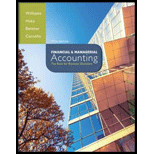
a.
Compute the missing amount using contribution margin per unit.
a.
Explanation of Solution
Contribution Margin:
The process or theory which is used to judge the benefit given by each unit of the goods produced is called as contribution margin.
The contribution margin is the difference between the selling price and the cost of the product.
Formula to compute the unit contribution margin:
| Sales | Variable Costs | Contribution Margin Ratio per Unit | Fixed Costs | Operating Income | Units Sold | ||
| (1) | $200,000 | $120,000 | $20 | $55,000 | $25,000 | 4,000 | |
| (2) | 180,000 | 105,000 | 15 | 45,000 | 30,000 | 5,000 | |
| (3) | 600,000 | 360,000 | 30 | 150,000 | 90,000 | 8,000 |
Table (1)
Working notes:
Calculate the amount of sales:
Step 1: Calculate the unit variable cost:
Step 2: Calculate the unit sales price:
Step 3: Calculate the amount of sales using contribution margin per unit:
Calculate the amount of variable costs using contribution margin per unit:
Calculate the amount of variable costs using contribution margin per unit:
Calculate contribution margin ratio per unit:
Step 1: Calculate unit variable cost.
Step 2: Calculate the unit sales price.
Step 3: Calculate contribution margin ratio per unit:
Calculate the amount of fixed costs:
Step 1: Calculate contribution margin.
Step 2: Calculate the amount of fixed costs.
Calculate the amount of units sold using contribution margin per unit:
b.
Compute the missing amount using contribution margin ratio.
b.
Explanation of Solution
Contribution Margin Ratio: The contribution margin ratio shows the amount of difference in the actual sales value and the variable expenses in percentage. This margin indicates that percentage which is available for sale above the fixed costs and the profit.
| Sales | Variable Costs | Margin Ratio (%) | Fixed Costs | Operating Income | ||
| (1) | $900,000 | $720,000 | 20% | $85,000 | $95,000 | |
| (2) | 600,000 | 360,000 | 40% | 165,000 | 75,000 | |
| (3) | 500,000 | 350,000 | 30% | 90,000 | 60,000 |
Table (1)
Working notes:
Calculate the contribution margin ratio:
Calculate the amount of fixed costs:
Step 1: Calculate contribution margin.
Step 2: Calculate the amount of fixed costs.
Calculate the amount of variable cost using contribution margin ratio:
Calculate the amount of fixed costs:
Step 1: Calculate contribution margin.
Step 2: Calculate the amount of fixed costs.
Calculate the amount of sales using contribution margin ratio:
Step 1: Calculate the amount of fixed costs.
Step 2: Calculate the amount of sales using contribution margin ratio:
Calculate the amount of variable cost using contribution margin ratio:
Want to see more full solutions like this?
Chapter 20 Solutions
Financial & Managerial Accounting
- Cariman contracts delivery drivers to service customers. Cariman owns the vans and pays for the gas. With reference to the following independent situations for Cariman, determine where (a) responsibility and (b) controllability lie. Suggest what might be done to solve the problem or to improve the situation: (20 marks)a) In the manufacturing plant the production manager is not happy with the material that the purchasing manager has been purchasing. In May the production manager stops requesting materials from the supply warehouse, and starts purchasing them directly from a different materials supplier. Actual materials costs in May are higher than budgeted.b) Overhead costs in the manufacturing plant for June are much higher than budgeted. Investigation reveals a utility rate hike in effect that was not figured into the budget.arrow_forwardprovide correct option please accounting questionarrow_forwardNeed help this question general accountingarrow_forward
- I am trying to find the accurate solution to this general accounting problem with appropriate explanations.arrow_forwardGeneral accounting questionarrow_forwardThe Snape Corporation has the following data for 2014: Selling price per unit $10 Variable costs per unit $6 Fixed costs Units sold $20,000 12,000 Snape's 2014 operating leverage is: a) 0.50 b) 2.00 c) 4.00 d) 1.71arrow_forward

 AccountingAccountingISBN:9781337272094Author:WARREN, Carl S., Reeve, James M., Duchac, Jonathan E.Publisher:Cengage Learning,
AccountingAccountingISBN:9781337272094Author:WARREN, Carl S., Reeve, James M., Duchac, Jonathan E.Publisher:Cengage Learning, Accounting Information SystemsAccountingISBN:9781337619202Author:Hall, James A.Publisher:Cengage Learning,
Accounting Information SystemsAccountingISBN:9781337619202Author:Hall, James A.Publisher:Cengage Learning, Horngren's Cost Accounting: A Managerial Emphasis...AccountingISBN:9780134475585Author:Srikant M. Datar, Madhav V. RajanPublisher:PEARSON
Horngren's Cost Accounting: A Managerial Emphasis...AccountingISBN:9780134475585Author:Srikant M. Datar, Madhav V. RajanPublisher:PEARSON Intermediate AccountingAccountingISBN:9781259722660Author:J. David Spiceland, Mark W. Nelson, Wayne M ThomasPublisher:McGraw-Hill Education
Intermediate AccountingAccountingISBN:9781259722660Author:J. David Spiceland, Mark W. Nelson, Wayne M ThomasPublisher:McGraw-Hill Education Financial and Managerial AccountingAccountingISBN:9781259726705Author:John J Wild, Ken W. Shaw, Barbara Chiappetta Fundamental Accounting PrinciplesPublisher:McGraw-Hill Education
Financial and Managerial AccountingAccountingISBN:9781259726705Author:John J Wild, Ken W. Shaw, Barbara Chiappetta Fundamental Accounting PrinciplesPublisher:McGraw-Hill Education





